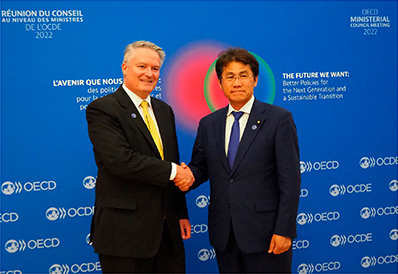3 Increasing Development Cooperation to Developing Countries by Emerging Donors and the Private-Sector

Then Parliamentary Vice-Minister for Foreign Affairs Miyake meeting with OECD Secretary-General Cormann during the OECD Ministerial Council Meeting in June 2022
Recent years have seen an increase in aid for developing countries provided by non-DAC emerging donors, such as China, India, Indonesia, Saudi Arabia, Brazil, Argentina, Mexico, Turkey, South Africa, and private foundations, in addition to the DAC members. Although only a few non-DAC countries report to DAC, according to DAC Statistics alone, the total amount of aid provided in 2021 was more than 19 billion US dollars by non-DAC countries, more than 270 billion US dollars of private funds by both DAC and non-DAC countries, and approximately 12 billion US dollars by NGOs. Note 17
As the Leaders’ Declaration adopted at the G20 Bali Summit states that the G20 will “Unlock further investments for low- and middle-income and other developing countries, through a greater variety of innovative financing sources and instruments, including to catalyze private investment, to support the achievement of the SDGs,” funding by various actors will need to be directed to developing countries, in order to achieve the SDGs. While the flow of funds to developing countries is diversifying, it is essential to accurately grasp the flow of funds and to effectively utilize limited development finance in order for the international community to promote development cooperation in a coordinated manner. However, the statistics prepared and published by the DAC do not reveal the full details of aid for developing countries provided by non-DAC countries. It has also been pointed out that there are opaque and unfair lending practices that do not conform to international rules and standards.
Under these circumstances, the need for the transparency of development finance and other such matters were discussed at various international forums in 2022, including the G7, G20, TICAD 8, and the OECD. For example, at the TICAD Ministerial Meeting held in March, Foreign Minister Hayashi took up the importance of transparent and fair development finance, while at TICAD 8 in August, Prime Minister Kishida emphasized in his video message the importance of ensuring transparent and fair development finance. At the G20 Development Ministerial Meeting held in September, State Minister for Foreign Affairs Takei emphasized the importance of solidly implementing elements such as transparency, openness, economic efficiency, debt sustainability, and consideration for the environment and society, as stipulated in the G20 Principles for Quality Infrastructure Investment. State Minister Takei also called on G20 countries to share similar efforts and knowledge and emphasized the importance of ensuring transparency and fairness in development finance and adhering to international rules and standards on development finance.
The Ministerial Council Statement adopted by the OECD Ministerial Council Meeting in June 2022 states that the member countries recognize the challenges to the OECD’s standards and norms by emerging donors and will reinforce their global engagement through consolidating the OECD’s role and advancing its standards globally. This follows the “OECD’s 60th Anniversary Vision Statement” adopted in October 2021, which sets out the OECD’s basic policies for the next 10 years, urging “all stakeholders” to promote compliance with the OECD standards and practices to improve transparency and accountability. The “Policy Statement on Future Perspectives for the Development Centre,” adopted at the Eighth High-Level Meeting of the Governing Board of the OECD Development Centre Note 18 in October, expressed the need to rectify transparency and accountability issues in areas such as debt and financial stability.
Japan will continue to work with the international community to ensure that aid for developing countries of emerging donors including China is transparent and consistent with international standards and initiatives (see Efforts on Debt Issues and Partnership with Other Countries and International Organizations).

- Note 17: OECD database (OECD.Stat) (December 2022)
- Note 18: An organization within the OECD that conducts studies and research on various development issues and economic policies. Its members include not only OECD member countries but also emerging donors and developing countries that are not members of the OECD, such as China.
